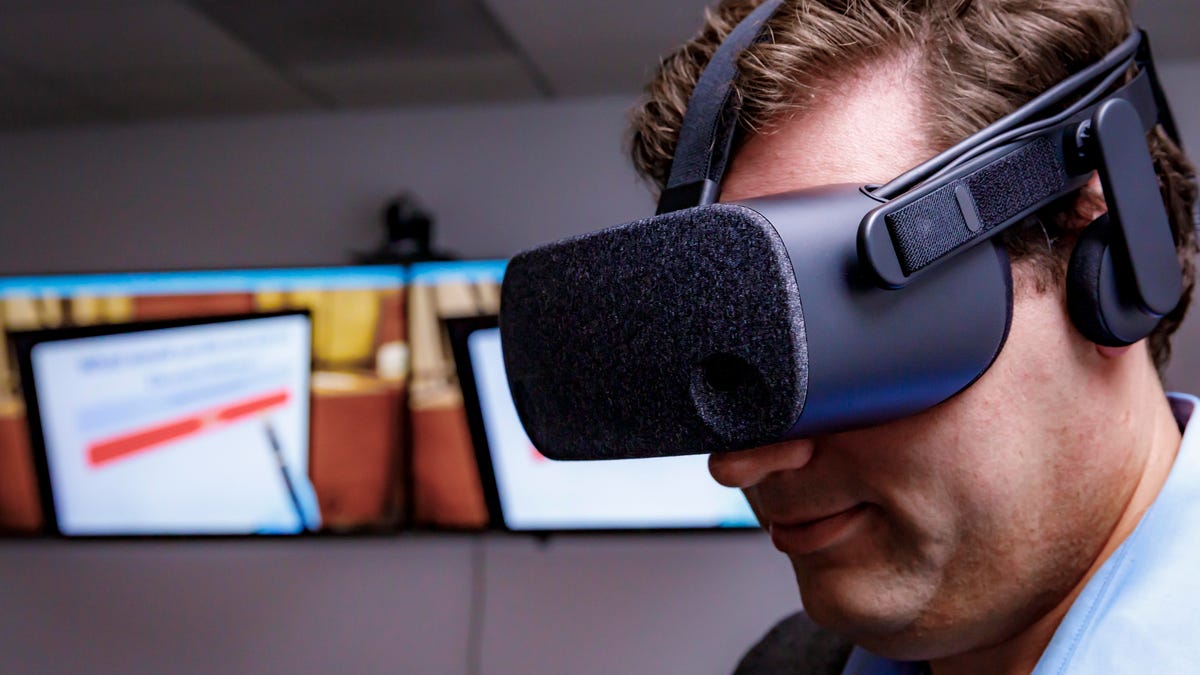HP Reverb gives Microsoft VR a high-res boost
The new $600 VR headset doubles up on the Samsung Odyssey and Vive Pro, arriving late April. We gave it a test drive.

Ian Sherr gives the HP Reverb a spin in San Francisco.
Virtual reality headsets are going through a hardware evolution, slowly, with eye tracking, wireless connections, wider fields of view and higher resolutions.
Companies are also catering their VR headsets to enterprise over consumer more now than they were a few years ago, when Oculus Rift and Vive were trying to win home crowds. The HP Reverb is a case in point: The first new Windows VR headset in years is going for professionals more than everyday consumers, with a $600 price tag and a focus on comfort and higher definition. An enterprise-targeted version of the HP Reverb will cost slightly more, at $649.
The HP Reverb arrives in late April. I tried one on and experienced a series of demos to see how it compared to the extremely impressive (and expensive) Varjo VR-1, which I demoed earlier this year. But, keep in mind the Varjo VR-1 costs $6,000: the Reverb is one tenth the price.
The HP Reverb's size is Oculus Rift-like.
How high-res is high-res?
Compared to the current highest-res mainstream VR headsets (the HTC Vive Pro and Samsung Odyssey), the HP Reverb looks crisper. I tried one on right after wearing Samsung Odyssey, and it felt like an optician had adjusted my vision a notch better. That being said, I could still see pixels. Standing at a fixed point in a virtual room and trying to read text on a virtual Windows screen on the wall, it was a better experience with HP Reverb, but not as good as looking at a big, 4K monitor.
The HP Reverb has 2,160x2,160 resolution per eye and a 114 degree field of view, both of which beat out other mainstream headsets (the Vive Pro is 1,440x1,600 per eye with a 110 degree field of view). HP's headset uses 2.89-inch LCD displays over OLED to improve pixel density, and a new squircle-shaped field of view and asymmetrical Fresnel lenses to make the viewing area wider at the sides, and smaller between the eyes where viewing area overlaps.
In terms of "pixels per degree," or pixel density, the HP Reverb display is about 24 to 25 pixels per degree, versus 14 to 15 pixels per degree on the Vive Pro or Samsung Odyssey. In comparison, the Microsoft HoloLens 2 is 47 pixels per degree (with a considerably smaller field of view), and the Varjo VR-1 gets to over 60 pixels per degree at the center of its display.
I tried several experiences: wandering around Microsoft's virtual cliff house VR loft lobby, playing with SteamVR's The Lab game and getting up close to virtual dragons and frogs, selecting surgical tools in a medical training program, and exploring a CAD design of a WeWork office, where I took a close peek at the texture of virtual pillows.
It all looked pretty sharp, but it didn't cross the "retina quality" threshold. I was more wowed by the Varjo VR-1, which had a pixel-free, perfect center resolution... but the Varjo headset also costs about $6,000. The HP Reverb does have other advantages, including a larger field of view, and the entire field is higher-res, while Varjo's headset is lower res (about 15 pixels per degree) at the periphery.
The HP Reverb uses Microsoft's wireless VR controllers and similar self-contained in-headset tracking as previous hardware.
One thing this headset lacks is eye tracking. The HP Reverb doesn't have internal cameras to notice eye movement and gaze, something HTC is adding to the upcoming Vive Pro Eye, and which Varjo includes in its high-end headset. HP's representatives had no comment on when an eye tracking version might appear.
For now, HP is trying to get to the next VR stepping stone without driving up price too much on the Reverb... or its size. The headset feels more compact and a bit lighter than pro-targeted headsets I've worn (1.1 pounds, compared to the HTC Vive Pro's 1.22 pounds), and about the same feel as the Oculus Rift headset (1.04 pounds). And it fit over my glasses fine.
The Reverb is a Windows VR headset, and uses the same wireless controllers that existing Windows VR headsets use. Inside-out tracking contained in the headset doesn't require room sensors, but it's still tethered. The ability to link right into Windows 10 means it can also work with Steam-compatible VR games, too.
The HP Reverb has its own built-in headphones, plus a 3.5 millimeter headphone jack, and has Bluetooth in-headset to allow controllers to wirelessly pair with it instead of the PC. The consumer version comes with a machine-washable foam face piece, while the enterprise model has a faster-to-wipe-clean leather face piece.

